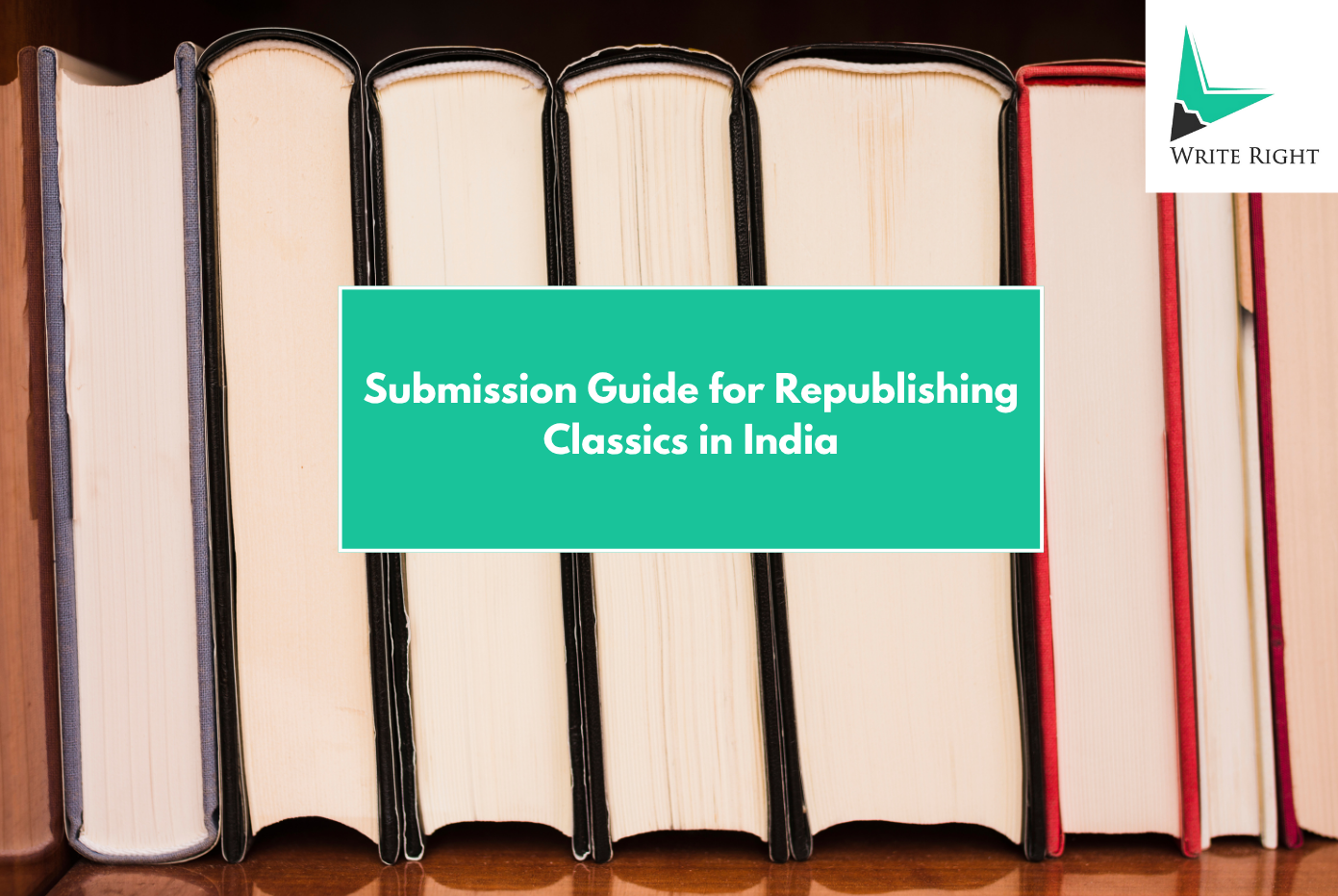Republishing a classic is more than just uploading an old manuscript. It’s a process that demands legal awareness, editorial discipline, and metadata precision. Indian authors often underestimate the importance of submission structure, which leads to delays, takedowns, or retailer confusion.
At Write Right, we’ve helped several authors build “classics-correct” editions that pass every rights, editorial, and catalog check. This guide walks you through each stage, from manuscript prep to metadata mapping, so your edition earns the credibility it deserves.
Why a Strong Submission Pack Matters
A complete submission pack helps publishers and distributors verify that your edition is original, rights-safe, and ready for the market. Many reprints fail because of missing proof of public-domain status, unclear edition labels, or incomplete contributor data.
A well-structured submission not only improves your acceptance rate but also strengthens your book’s discoverability on platforms like Amazon, Google Books, and libraries.
Bring Classics Back to Life
Write Right helps you republish timeless books with expert editing, modern design, and flawless production, keeping their legacy intact for today’s readers.
1. Step One: Verify Public-Domain Status
Before you finalize your manuscript, confirm whether the original text is legally in the public domain in India.
In most cases, works enter the public domain 60 years after the author’s death, but translations, forewords, and illustrations can still carry copyright.
Checklist:
-
Confirm the author’s death year and jurisdiction
-
Verify if the translation or adaptation is still under copyright
-
Document the source edition and include a citation
-
Log image or artwork rights if used
Tip from Write Right: Always include a PD Diligence Log in your submission. It acts as your first line of defense against copyright disputes.
2. Step Two: Define Your Edition Type
Classics publishing demands clarity. Publishers want to know what kind of edition you are submitting.
Common edition types include:
-
New Translation: For texts originally written in another language
-
Annotated Edition: Adds notes, glossaries, and context for readers
-
Illustrated Edition: Features public-domain or newly commissioned artwork
-
Gift Edition: Focuses on aesthetic presentation and packaging
Write Right recommends explicitly naming your edition, such as “The Iliad – Annotated Edition by [Your Name]”, to avoid confusion during ISBN and metadata registration.
3. Step Three: Collate and Quality-Check Your Source Text
Source integrity is what separates a credible classic from a reprint. Every text should have a documented base copy and a variant log for transparency.
Your QC folder should include:
-
Copy-text identification (edition and publisher)
-
Emendation and modernization notes (spelling, punctuation, formatting)
-
Proofreading certificates if outsourced
-
Release note for any changes made
Pro Tip: Write Right offers an in-house Source Collation Sheet template that tracks textual variants and ensures your version remains defensible in reviews or academic use.
Preserve History Through Professional Republishing
At Write Right, we give classic books a renewed presence with refined editing, premium layouts, and publishing strategies that attract modern readers.
4. Step Four: Prepare the Apparatus and Layout
Footnotes, endnotes, timelines, and bibliographies add value to your edition. The challenge lies in balance—too few make it look shallow, too many make it unreadable.
Essentials of a clean apparatus:
-
Keep notes brief and reader-oriented
-
Use consistent abbreviations and reference style
-
Include index and bibliography for research editions
-
Use clear typographic hierarchy (font, size, spacing)
Write Right’s editorial design team helps structure apparatus pages so that the academic value remains visible without affecting readability.
5. Step Five: Clear All Image and Artwork Permissions
Even when an artwork is public domain, photographs of it may still carry rights. Museums, archives, and libraries often require reproduction approvals.
Include in your pack:
-
Image source and credit line
-
Museum or archive permission email (if applicable)
-
Resolution details and caption standards
-
Model or property releases, if any identifiable subjects exist
Case Study:
A Write Right author publishing Tagore’s Illustrated Works used public-domain paintings from the NGMA archives. When the archive requested attribution, our team helped negotiate proper credits, allowing the book to stay listed without any takedown.
6. Step Six: Metadata and ISBN Mapping
Metadata decides how your book appears in online and retail catalogs. A single misstep—like reusing an ISBN or omitting translator data—can lead to misclassification or returns.
Metadata essentials:
-
Edition name (e.g., “Critical Edition”, “Illustrated Edition”)
-
Contributor roles (author, translator, illustrator, editor)
-
Publication date, ISBN per format (print, ebook, audiobook)
-
ONIX data with correct edition tags
-
Keywords that reflect edition type, not just “classics”
Case Study:
A Write Right client reissued The Panchatantra Annotated Edition. By assigning unique ISBNs to paperback, hardcover, and Kindle formats, we avoided metadata clashes that caused duplicate listings earlier.
7. Step Seven: Assemble the Submission Packet
Now put everything together in a structured and verifiable format.
Your submission pack should include:
-
Proposal summary (edition type + rationale + target readers)
-
PD Diligence Log
-
Source Collation Sheet
-
Annotated sample pages
-
Apparatus and layout plan
-
Artwork permissions bundle
-
Metadata Mapper (ISBNs, keywords, edition name)
Write Right offers a downloadable Classics Submission Toolkit containing editable templates for each of these components.
Give Old Stories a Modern Touch
Write Right’s republishing services revive vintage titles with precision editing, beautiful design, and high-quality printing for today’s readers.
8. Red Flags That Can Get Your Edition Rejected
Many authors lose credibility because of these avoidable issues:
-
Using undated, unsourced manuscripts
-
Mixing translations from multiple editions
-
Reproducing images without credit
-
Claiming new copyright on unedited public-domain text
-
Omitting variant or modernization disclosures
Every classic needs a transparent trail of editorial and rights diligence. This is where Write Right’s Classics Division helps authors build compliant, professional-grade editions that retailers trust.
Conclusion
Turning a classic manuscript into a publishable, metadata-ready edition is about precision and ethics. Each element—rights verification, source collation, apparatus, and ISBN mapping—plays a vital role in protecting your credibility and long-term brand. At Write Right, we help Indian authors move from raw manuscript to publication-ready metadata with tools, templates, and expert review.
Ready to publish your own classic responsibly?
Contact Write Right’s Classics Submission Division and book a free 15-minute consultation with our editorial specialists.
FAQs
1. How do I confirm if a classic is in the public domain in India?
Check the author’s death year. Works enter the public domain 60 years after the author’s death in India. But translations, essays, and illustrations can still be protected, so log each source’s copyright status.
2. Can I modernize the language or spelling of a classic?
Yes, but document every change in a modernization policy. Publishers and reviewers appreciate transparency in how you updated the text.
3. What should my edition title include?
Always specify edition type, such as “Annotated Edition” or “New Translation by [Name].” This helps in metadata mapping and reduces listing confusion.
4. Do I need new ISBNs for each format?
Yes. Assign separate ISBNs for print, ebook, and audiobook versions to prevent catalog conflicts or duplicate returns.
5. What if I use artwork from museum archives?
Even if the artwork is in the public domain, the photo or scan may still be copyrighted. Obtain permission from the museum and credit them correctly.





